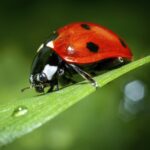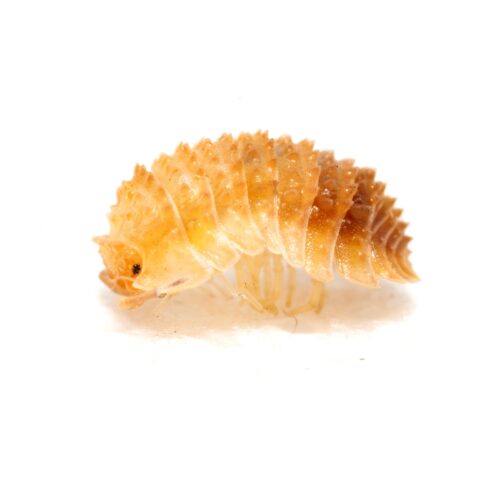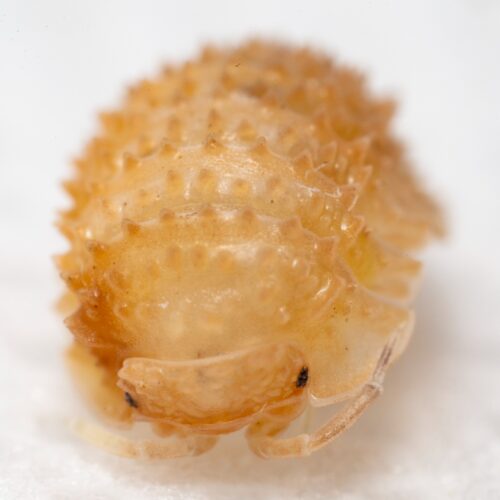
Coccinella septempunctata
15,00€ – 25,00€Price range: 15,00€ through 25,00€

Isopod Starter Kit
14,00€
Porcellio ornatus high yellow
3,00€
Explore the fascinating Porcellio ornatus “High Yellow”! An exotic isopod with a vibrant yellow color, ideal for collectors and nature lovers. Easy to care for and perfect for terrariums and educational projects. 🌟 #Isopods
SKU:
N/A
Categories: Arthropods, Isopods, Porcellio
Description
Technical Sheet for Porcellio ornatus “High Yellow”
1. General Description
Common Name: High Yellow Isopod
Scientific Name: Porcellio ornatus “High Yellow”
Family: Porcellionidae
Order: Isopoda
Class: Malacostraca
Phylum: Arthropoda
Kingdom: Animalia
2. Morphology and Appearance
- Coloration: Porcellio ornatus “High Yellow” is characterized by a predominantly bright yellow body with black and grey patterns. The intensity of the yellow may vary, but it is noted for being vibrant.
- Size: Adults reach a length of between 1.5 and 2.2 cm.
- Body Shape: Dorsally flattened, with a segmented and rigid exoskeleton.
- Antennae: Two pairs of antennae, with the first pair being short and the second pair longer and more sensitive.
3. Distribution and Habitat
- Geographical Distribution: Native to Mediterranean regions, especially southern Europe.
- Natural Habitat: Commonly found in moist and shady environments such as under rocks, logs, and leaf litter. Prefers well-drained soils rich in organic matter.
4. Behavior and Ecology
- Diet: Detritivore, primarily feeds on decaying plant material but can also consume fungi and dead animal matter.
- Activity: Primarily nocturnal, seeking shelter during the day to avoid dehydration.
- Reproduction: Reproduction is ovoviviparous. Females carry the eggs in a ventral pouch until they hatch.
- Life Cycle: Development from egg to adult takes approximately 3 to 4 months. Longevity can reach up to 2 years under favorable conditions.
5. Captive Care Conditions
- Temperature: Optimal range between 20°C and 25°C.
- Humidity: Requires high humidity, preferably between 70% and 90%.
- Substrate: Suitable substrate composed of a mix of soil, coconut fiber, and dried leaves. It is important to keep it slightly moist but not soaked.
- Feeding in Captivity: Can be fed a varied diet including fresh vegetables, fruits, dried leaves, and occasionally specialized isopod food available in pet stores.
- Shelter: Provide plenty of hiding material such as bark, pieces of wood, and flat stones.
- Compatibility: Peaceful and sociable, can be kept in groups without aggression issues.
6. Health and Special Care
- Disease Prevention: Maintaining proper humidity and avoiding the accumulation of mold and fungi is crucial to prevent fungal infections.
- Health Observations: Require a clean environment. It is important to remove uneaten food to prevent health problems.
- Common Problems: Dehydration is the most common issue due to moisture loss in the environment.
7. Human Interaction
- Handling: It is recommended to handle them carefully, as although they are harmless, they can easily become stressed.
- Educational Use: Ideal for educational projects due to their easy care and interesting behavior.
Additional information
| Options |
1 unit |
|---|
Related products
Brachypelma hamorii (ex smithi)
12,00€ – 90,00€Price range: 12,00€ through 90,00€
there is stock
Transform your terrarium into a vibrant haven with this unique tarantula. Ideal for beginners in tarantula breeding! Discover the fascinating world of these arachnids, an unforgettable learning experience!
Select options
This product has multiple variants. The options may be chosen on the product page
Cristarmadillidium muricatum
2,50€ – 10,00€Price range: 2,50€ through 10,00€
there is stock
A natural wonder with Cristarmadillidium muricatum! Discover how tiny isopods can inspire greatness. Add a touch of wonder to your terrarium with this furry isopod. Get it now!
Select options
This product has multiple variants. The options may be chosen on the product page
Gromphadorhina portentosa
1,50€ – 12,00€Price range: 1,50€ through 12,00€
there is stock
Discover the fascinating Madagascar hissing cockroach! Perfect as an exotic pet or for research projects. Its peculiarity and ease of care make it a unique choice. Dare to explore the world of these incredible creatures!
Select options
This product has multiple variants. The options may be chosen on the product page
Shelfordella lateralis (ex tartara)(10 units)
1,99€
there is stock
Blaptica Dubia
1,99€ – 9,00€Price range: 1,99€ through 9,00€
there is stock
Blaptica dubia. (live food)
Discover this fantastic food loaded with protein, ideal for ant colonies. An ideal power source to have an entire colony of ants active. This live food is ideal for feeding certain insects, reptiles, amphibians.
Select options
This product has multiple variants. The options may be chosen on the product page
Stick insect (Medauroidea extradentata)
5,00€
Sold out
Common name: Stick insect Scientific name: Medauroidea extradentata Taxonomic classification: Kingdom: Animalia Phylum: Arthropoda Class: Insecta Order: Phasmatodea Family: Phasmatidae
Select options
This product has multiple variants. The options may be chosen on the product page
Achrioptera manga (fallax)
8,00€
Sold out
Armadillidium klugii
3,00€ – 12,50€Price range: 3,00€ through 12,50€
Sold out
Select options
This product has multiple variants. The options may be chosen on the product page























